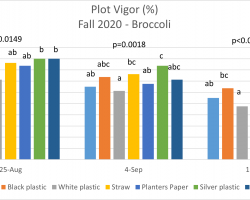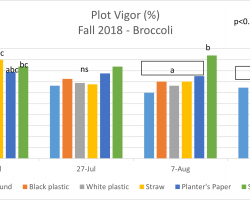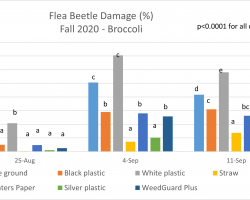Background and Objectives
Prior to conducting these trials, we had anecdotally observed differences in flea beetle damage in plants grown in certain types of mulches. To clarify these observations, we set out to determine:
- if mulches can reduce flea beetle damage to brassica crops,
- if mulches can increase crop quality and/or yield, and
- which mulches are best at reducing damage and increasing quality and yield
Methods
This trial was repeated five times between 2018 and 2020 – three times with broccoli and two times with bok choy, and four times in the fall and once in the spring. This report will focus on the two fall broccoli trials, which took place in fall 2018 and fall 2020. In both trials, the untreated control was bare ground production. In the fall 2018 trial, five mulches were evaluated: black plastic (1 mm black embossed), white plastic (1 mm white on black embossed), silver plastic (1 mm metalized silver embossed), Planter’s Paper, and straw. In the three subsequent trials, an additional paper mulch, WeedGuard Plus, was evaluated. Each treatment was replicated four times in each trial.
In both trials, raised beds were formed on 5’ centers. Within each bed, plots were 10’ long with 5’ buffers between plots. Broccoli (‘Arcadia’ in 2018 and ‘Imperial’ in 2020) was planted in 2 rows/bed at 10” spacing in-row, with 12” between rows. Soil temperature monitors were buried 2” below the soil surface and under the mulch cover. Bare ground buffer beds were planted on either side of the trial as well as down the middle of each trial.
Trial areas were amended with fertilizer according to soil test results, using Allganic (15.5-0-0) and potash (0-0-50). Raised beds were formed and mulches were laid by hand over one line of drip tape. Plastic and paper mulches were secured with soil along the edges. Straw mulch was applied to a depth of 4”. Trials were drip-irrigated as needed and treated with Dipel (1 lb/A) and M-Pede (2% v/v) as needed to control caterpillar pests and aphids.
In all trials, flea beetle damage and whole plot vigor were rated weekly. Whole plot vigor (0-100%) was a visual assessment of stand, plant size, and leaf color. Flea beetle damage was rated as a percentage in all trials except for the fall 2018 trial, when it was rated on the following damage scale: 0=0%; 1=0-10%; 2=11-25%; 3=26-50%; 4=>50%. In both trials, weekly plant height and total plant weight at harvest were also recorded. Plant height did not end up reflecting the overall vigor of the plants and the mulches did not have a consistent effect on harvest weights, so neither of those two measures will be discussed in this report. All data were analyzed using Proc GLM in SAS and means were separated using Tukey’s HSD.
Results & Discussion
The data from both fall broccoli trials shows that mulches can influence flea beetle behavior but it’s not clear how or to what extent. There were trends in the data from these trials that show the silver plastic mulch improved vigor and reduced flea beetle damage, compared to the bare ground production, but the effect was not consistent or strong enough to warrant recommending the adoption of silver mulch in brassica production. All other mulches, except for white plastic, also reduced flea beetle damage at various points in the two fall broccoli trials but again, those results were not consistent throughout the length of the trials and the effects were not strong.
This trial was conducted twice using bok choy – once in the spring and once in the fall. In both bok choy trials, the bok choy was highly attractive to flea beetles, resulting in little-to-no reduction in damage from the mulches.
Conclusions
In our opinion, the effects of the mulches in these trials were not strong enough to warrant using mulch in commercial brassica production. Given the added costs that come with using mulch (mulch costs and labor), mulch use would need to be backed up by a drastic reduction in flea beetle damage. The silver plastic mulch was the only treatment that consistently reduced flea beetle damage and increased plant vigor but the effect was not strong enough to warrant the additional cost of silver plastic ($11/100 row ft compared to $3/100 row ft for black plastic mulch) and difficulty of working with the reflective material. For growers who have a high tolerance for flea beetle damage and do not want to spray insecticides or use row cover, silver mulch may reduce damage in waxy brassica crops but will not eliminate the pest entirely.
This material is based upon work supported by the National Institute of Food and Agriculture, U.S. Department of Agriculture, through the Northeast Sustainable Agriculture Research and Education program under subaward number LNE18-365.




